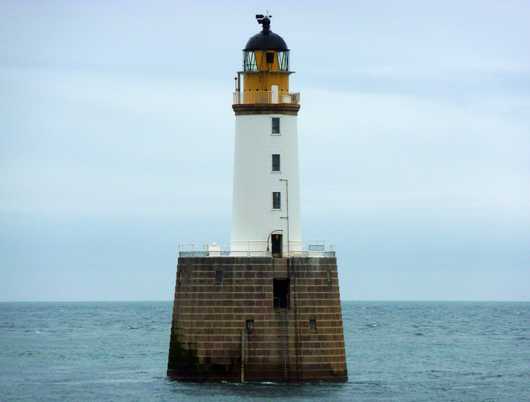Rattray Head

The lighthouse at Rattray Head is perhaps one of the more unusual structures in the Northern Lighthouse Board's catalogue. Many vessels have been wrecked on the Rattray Briggs, a rocky outcrop just off of Rattray head, so when experiments in the late 1850s to show a red sector from Buchan Ness proved impractical the Northern Lighthouse Board looked into constructing a lighthouse nearby. Trinity House originally advised the Northern Lighthouse Board to just mark the Briggs with a buoy with a bell and were against the idea of building a Lighthouse, however the NLB instead decided to go against this advice and pressed ahead with the lighthouse.
In 1892 work started on the lighthouses. The distinctive lower half is much wider than the tower, designed in such a way to deflect waves, but also to be spacious enough to accomodate the fuel tanks, engines, compressors and air tanks required for a powerful compressed air fog signal. The walls of this part of the structure are made of large dressed granite blocks, the majority having been mined at Rubislaw quarry in Aberdeen, and alone this part of the lighthouse is 14 meters in height.
Up on the open deck level at the base of the main lighthouse tower there was once a red fog signal trumpet much like those found at many of the NLB's land-based light stations, however this was removed prior to the station's automation.
The upper portion of the stucture, comprising of the main tower and lantern is 20 metres in height, and includes the keeper's accomodation. The lantern originally contained a large fresnel lens, and the light was changed to an electric lamp in 1977 when a under-sea cable was laid to the lighthouse, however all of the internal machinery was replaced and the lens swapped out for a set of sealed beam units in the automation upgrades in 1982. The sealed beam units, which are similar to a bank of car headlights, rotate and give a group of 3 white flashes every 30 seconds, visible at a range of 24 nautical miles. Nowadays the large fresnel lens and the clockwork mechanism that drove it is on display in the Aberdeen Maritime Museum.
During WWII, Rattray Head was circled by an enemy aircraft, which dropped 3 bombs on the site, of which only 2 detonated. The tower was also machine-gunned. None of the keepers were injured in the attack and the lighthouse recieved only slight damage to the lantern room, allowing the light to continue normal operation.
On the shore, enroute to the Lighthouse there is a block of old keeper's cottages where the keepers were housed when off-station and where their families lived permanently.

